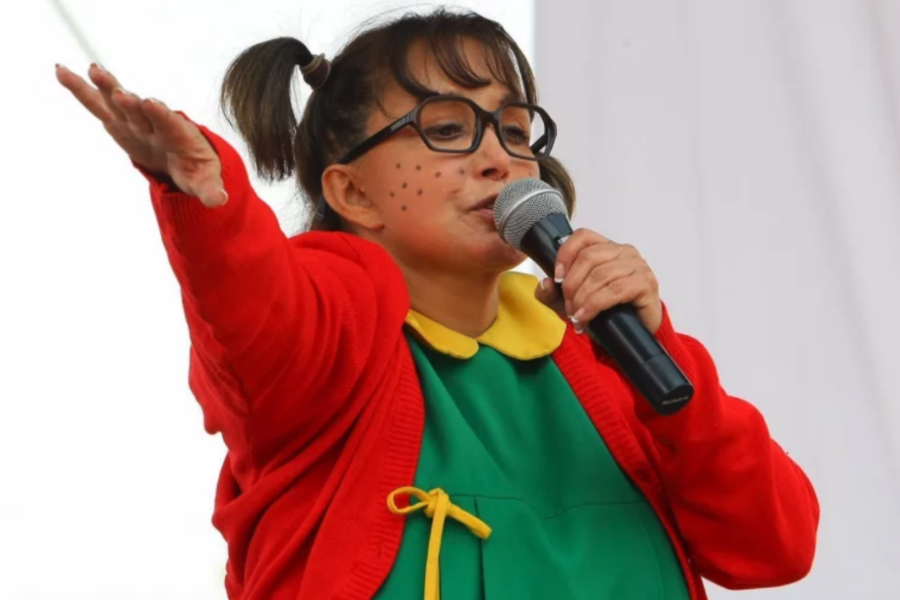Chiñindrina: A Cultural Icon with Deep Roots
Chiñindrina is a term that deeply resonates within Mexican culture, embodying a rich tapestry of history, entertainment, and culinary tradition. Whether you’re familiar with La Chilindrina from the beloved television show El Chavo del Ocho or have tasted the delightful Chiñindrina dish from a Mexican street vendor, the influence of this cultural icon is undeniable. This article delves into the various facets of Chiñindrina, exploring its origins, cultural impact, role in modern media, and culinary significance. We will examine how Chiñindrina has shaped popular culture, been celebrated in festivals, and influenced education, providing a comprehensive look at this multifaceted icon.
What is Chiñindrina?
Chiñindrina represents two distinct elements of Mexican culture: a beloved character from the classic television show El Chavo del Ocho and a popular street food dish. La Chilindrina, portrayed by María Antonieta de las Nieves, is known for her distinctive pigtails, freckles, and glasses, capturing the mischievous yet endearing spirit of childhood. The character has become an iconic figure in Latin American pop culture, symbolizing the humor and challenges of everyday life. Meanwhile, the Chiñindrina dish—composed of a crispy tortilla base topped with ingredients like avocado, crema, and chicharrón—embodies the creativity of Mexican street food, offering a flavorful and satisfying meal that has become a staple in markets and food stalls across Mexico.
The Origins of Chiñindrina
The origins of Chiñindrina are rooted in the creative genius of Roberto Gómez Bolaños, known as Chespirito, who created La Chilindrina for the television show El Chavo del Ocho. The character quickly became a fan favorite due to her relatable antics and portrayal of a typical child in a Mexican neighborhood. On the culinary side, the Chiñindrina dish emerged from Mexico’s vibrant street food culture, where vendors combined crispy tortillas with a variety of flavorful toppings, creating a beloved snack among locals.
Cultural Impact of Chiñindrina
Chiñindrina has made a profound impact on Latin American culture. La Chilindrina, with her distinctive appearance and personality, has become a symbol of innocence, mischief, and resilience. Her role in El Chavo del Ocho has cemented her status as a cultural icon, with references to her character appearing across various media forms, from television to internet memes. The character’s impact extends beyond the screen, influencing fashion, language, and social dynamics, as her interactions on the show often highlight important social themes.
La Chilindrina in Popular Media
La Chilindrina’s influence on popular media is significant. Her image and catchphrases are instantly recognizable throughout Latin America. The character has been referenced in numerous television shows, parodies, and internet memes, demonstrating her lasting presence in both traditional and digital media.
Influence on Mexican Identity
La Chilindrina has also contributed to shaping Mexican identity, particularly in how childhood and family dynamics are portrayed. Her interactions in El Chavo del Ocho reflect the values, challenges, and humor of everyday Mexican life, making her a symbol of the nation’s cultural fabric.
Culinary Influence of Chiñindrina
The Chiñindrina dish has made its mark in the realm of Mexican street food. Its popularity extends beyond local markets to food festivals and culinary events, showcasing the creativity and diversity of Mexican cuisine. The dish’s adaptability and appeal continue to make it a favorite among food enthusiasts.
Chiñindrina in Modern Culture
In contemporary culture, Chiñindrina remains a cherished figure, especially as nostalgia for El Chavo del Ocho persists. La Chilindrina is often evoked in discussions about childhood and television’s golden age in Latin America. Her image continues to appear in various media, from cartoons to internet memes, highlighting her enduring relevance. Fans celebrate her iconic look and personality through fan art and cosplay.
Similarly, the Chiñindrina dish maintains its place in modern culinary culture. As food trends shift towards traditional and authentic experiences, interest in street foods like Chiñindrina has renewed. Food festivals and markets across Mexico often feature this dish, allowing new generations to discover its rich flavors and cultural significance. Chefs and food enthusiasts continue to innovate, creating gourmet versions that bring Chiñindrina into contemporary culinary conversations.
Chiñindrina’s Role in El Chavo del Ocho
Character Traits and Relationships
La Chilindrina is a central figure in El Chavo del Ocho, known for her mischievous behavior and strong personality. As the daughter of Don Ramón, another beloved character, her interactions with him and other neighborhood children often lead to humorous and heartwarming situations. La Chilindrina’s traits include quick wit, occasional selfishness, and deep affection for her father, adding depth to her character and making her relatable to the audience.
Memorable Moments
- The Prankster: La Chilindrina is known for her pranks, including a memorable moment where she convinces El Chavo that a simple piece of string is a magic tool, leading to a series of comedic misunderstandings.
- Father-Daughter Moments: Her relationship with Don Ramón is a central aspect of her character, with episodes often highlighting their bond. These moments are filled with warmth and humor.
- Rivalries and Friendships: Her interactions with other children, such as Quico and La Popis, provide much of the show’s comedy. Her rivalry with Quico, in particular, leads to many classic confrontations.
Celebrating Chiñindrina: Festivals and Culinary Events
La Chilindrina-Themed Festivals
In Mexico, festivals celebrating El Chavo del Ocho and its characters, including La Chilindrina, are held regularly. These events often feature costume contests, live performances, and screenings of classic episodes, allowing fans to relive the magic of the show and celebrate its cultural significance.
Street Food Festivals Featuring Chiñindrina
The Chiñindrina dish is a highlight at street food festivals, where vendors and chefs present both traditional and modern versions. These events celebrate the dish’s flavors and encourage culinary innovation, with new twists attracting food lovers from all over.
Culinary Competitions and Workshops
Culinary competitions and workshops dedicated to Chiñindrina offer opportunities for chefs and home cooks to showcase their skills. These events emphasize the dish’s versatility and cultural importance, allowing participants to learn and experiment while honoring its traditional roots.
Chiñindrina’s Role in Education
La Chilindrina’s influence extends into education. Episodes of El Chavo del Ocho are used as educational tools to teach values such as honesty, friendship, and the importance of education. The character’s relatable experiences make her an effective medium for conveying important life lessons. Additionally, La Chilindrina has been the subject of academic studies exploring her role in media, gender representation, and cultural identity.
Chiñindrina’s Future Plans
- Revival of El Chavo del Ocho: Potential new adaptations of the show could introduce La Chilindrina to a new generation.
- Expansion into Digital Media: Development of digital content such as animated series, web shorts, or mobile apps featuring La Chilindrina.
- Global Culinary Reach: Introduction of the Chiñindrina dish to international markets, with potential fusion dishes combining Mexican and global flavors.
- Continued Cultural Celebrations: Ongoing festivals, merchandise, and events celebrating La Chilindrina and the Chiñindrina dish.
How to Make Your Own Chiñindrina at Home
Experience the deliciousness of Chiñindrina at home with this simple recipe. Customize it to suit your taste and enjoy a taste of Mexico’s rich street food tradition.
Ingredients
- Tostadas or fried tortillas (for the base)
- Avocado, sliced
- Crema (Mexican sour cream)
- Chicharrón (fried pork skin) or shredded beef
- Refried beans
- Lettuce, shredded
- Queso fresco (fresh cheese), crumbled
- Salsa (your choice of red or green)
Preparation Steps
- Prepare the Base: Lay out the tostadas or fried tortillas on a large plate. These will serve as the base for your Chiñindrina.
- Layer the Ingredients: Spread a layer of refried beans over the tostadas, followed by slices of avocado. Add the chicharrón or shredded beef, ensuring each tostada has a generous amount.
- Add Toppings: Top with shredded lettuce, a dollop of crema, and crumbled queso fresco. Drizzle with salsa for added flavor.
- Serve and Enjoy: Serve immediately to maintain the crispiness of the tostadas.
This dish is perfect for casual meals or festive occasions, bringing a taste of Mexico’s street food tradition into your home.
Embracing the Legacy of Chiñindrina
As explored throughout this article, Chiñindrina is more than a television character or street food dish; she embodies a piece of Mexican culture that has endured for decades. From the laughter she has brought to audiences to the flavors she has offered food lovers, Chiñindrina’s legacy is one of creativity, resilience, and joy. Looking to the future, Chiñindrina will continue to inspire and delight, reminding us of the rich cultural heritage she represents.
The Bottom Line
Chiñindrina is a cultural icon with a lasting impact on both Mexican entertainment and cuisine. From her origins in El Chavo del Ocho to her influence in modern media and food festivals, Chiñindrina remains a beloved figure that resonates globally. Her story blends tradition with innovation, and she will continue to be a cherished part of Mexican culture for years to come. Whether reminiscing about classic television moments or savoring a delicious Chiñindrina dish, we celebrate the enduring legacy of this remarkable icon.
Explore in-depth profiles of healthcare leaders and innovators at vlineperol.blog.







